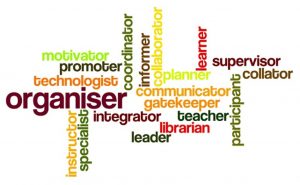If there’s anything I’ve learnt over the past few weeks, it’s that teacher-librarians need to be proficient multitaskers. A glance at the word cloud below shows just how diverse the teacher-librarian’s roles can be.

Image credit: hopefullyateacherlibrianinthemaking
Theme 2 of LIBE 467 has specifically focused on the role of the teacher-librarian as a reference resource manager, promotor, and collaborator.
First of all, an important part of the teacher-librarian’s role is to manage the SLLC’s resources. As stated by the Greater Victoria School District, this includes “establishing and maintaining effective systems for the selection, acquisition, processing, and circulation of resources” and “managing the library facilities, services and budget in order that these may contribute to the stated goals of the school, school district, and Ministry of Education” (The University of British-Columbia-a, 2021). This means that it is the teacher-librarian’s responsibility to select all fiction, non-fiction, and reference materials, as well as technology resources for the SLLC.
In my opinion, caring for and developing the library’s reference collection is probably the most challenging resource management task the teacher-librarian will face. This is due to two reasons.
First reference materials are expensive. The average cost of a print reference book is 50-100$ while database access is around 0.50-1.50$ per student (The University of British-Columbia-a, 2021). Furthermore, reference resources need to be updated or replaced regularly to avoid obsolescence. For example, Riedling and Houston state that an atlas “that is five years old or more portrays enough obsolete information to be considered only for historical purposes” (2019, p. 78). When we factor in limited school library budgets, we begin to realise what a challenge it is to maintain a current and accurate collection.
Second, reference materials need to be chosen with various criteria in mind. While Riedling and Houston propose general criteria that can help evaluate print and digital resources, there is no formulaic recipe to select material. The teacher-librarian must do the groundwork to evaluate a reference resource according to the specific needs of the learning community, and respecting curriculum and ministry expectations and guidelines.
To meet an acceptable standard, the library collection must at a minimum provide “some materials that reflect the unique needs of the specific school population” (Canadian Association for School Libraries, 2003). To effectively choose the material that suits the community’s needs, the teacher-librarian should collect and analyse data based on students’ and teachers’ needs. This could be done through formal means, such as surveys or statistical analysis, or informal means, such as staff/student discussions and feedback.
Next, the teacher-librarian must evaluate a resource through the lens of curriculum and ministry expectations. ERAC provides a useful guide to evaluating, selecting, and acquiring learning resources. Unfortunately, however, the last time the guide was revised was in 2008. Considering how much digital learning resources have evolved over the past decade, and how various provinces (including BC) have introduced new curriculums since 2008, I believe ERAC’s guide could greatly benefit from an update.
Selecting reference resources is not a simple task which is why I believe it is important for the teacher-librarian to keep in mind three key components:
- The SLLC should provide students with a balanced range of print and digital reference resources
- Reference resources in the SLLC should be diverse and accommodate the interests, experiences, learning styles, needs, and ability levels of the school community.
- Reference resources should develop a variety of literacy skills and explore different curriculum areas and expectations.
Resource management can take up a lot of the teacher-librarian’s time. However, an essential part of the teacher-librarian’s role that should not be overlooked is promoting resources by collaborating with classroom teachers. What use is the reference collection if it’s left to collect dust in the library?
While Riedling and Houston focus on providing reference services through the Reference Interview, a more effective, realistic, and indeed necessary approach is to focus on collaborating with classroom teachers. Cooperative Program Planning allows teachers to focus on “the process involved in doing a research assignment and the inherent skills in the process” (The University of British-Columbia-b, 2021). Through collaborative planning, the teacher-librarian can help guide students through the reference collection and help them gain essential research and reference skills.
To conclude, the video below gives an excellent explanation of how teacher-librarians support classroom teachers to provide students with the best learning experience.
Bibliography
Canadian Association for School Libraries. (2003). Achieving Information Literacy: Standards for School Library Programs in Canada. Ottawa: Canadian School Library Association and the Association for Teacher-Librarianship in Canada.
ERAC. (2008). Evaluating, Selecting and Acquiring Learning Resources: A Guide.
Riedling, A. M., & Houston, C. (2019). Reference Skills For The School Librarian: Tools and Tips Fourth Edition. Santa Barbara: Libraries Unlimited.
Students Need School Libraries. (2018, October 15). Teachers + Teacher Librarians = Better Learning. Retrieved from YouTube: https://www.youtube.com/watch?v=uKtZ_unsHHo
The University of British-Columbia-a. (2021). Lesson 6: Managing the Reference Collection. Retrieved from LIBE 467 63C 2020W Information Services I: https://canvas.ubc.ca/courses/60431/pages/lesson-6-managing-the-reference-collection?module_item_id=1865100
The University of British-Columbia-b. (2021). Lesson 5: The Reference Interview: Cooperative Program Planning and Teaching for Personalized Inquiry. Retrieved from LIBE 467 63C 2020W Information Services I: https://canvas.ubc.ca/courses/60431/pages/lesson-5-the-reference-interview-cooperative-program-planning-and-teaching-for-personalized-inquiry?module_item_id=1865098
Hi Danielle,
You make a great point about how developing and caring for the reference collection would probably be one of the most challenging aspects of resource management. As someone who is not yet in the TL role managing the reference section of the library seems a bit intimidating!